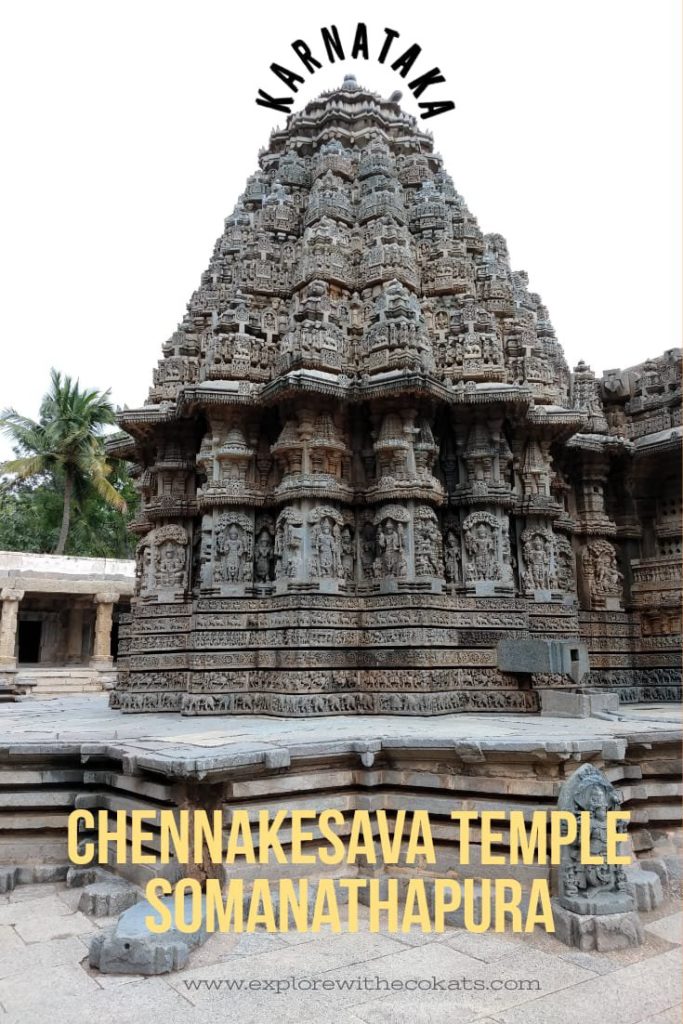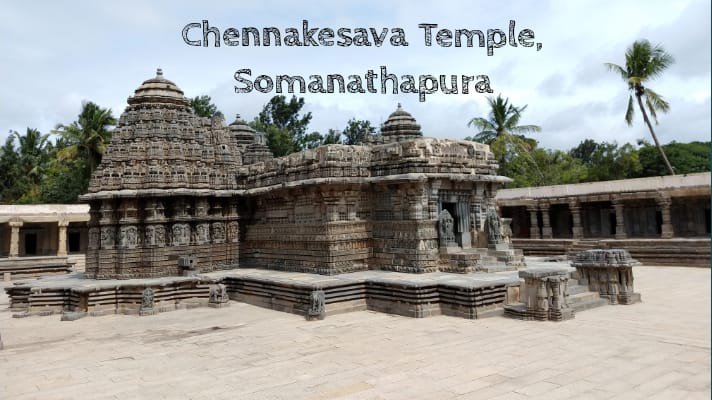Last Updated on July 6, 2024 by
Chennakesava Temple Somanathapura is a perfect one-day trip from Mysore. Also known as Somanathapura temple, it is one of the Hoysala temples.
Popular for its walls, this temple has sculptures that are lavishly crafted with incredible details of deities, motifs and sculptures from everyday life. Some carvings also depict scenes from Hindu literature such as Ramayana, Mahabharata and the childhood of Lord Krishna. The fact that it has stood for so many centuries is a testament to the amazing engineering and artistry of the bygone era. I combined my Shivanasamudra falls trip to visit this temple and marvel at the beautiful carvings.
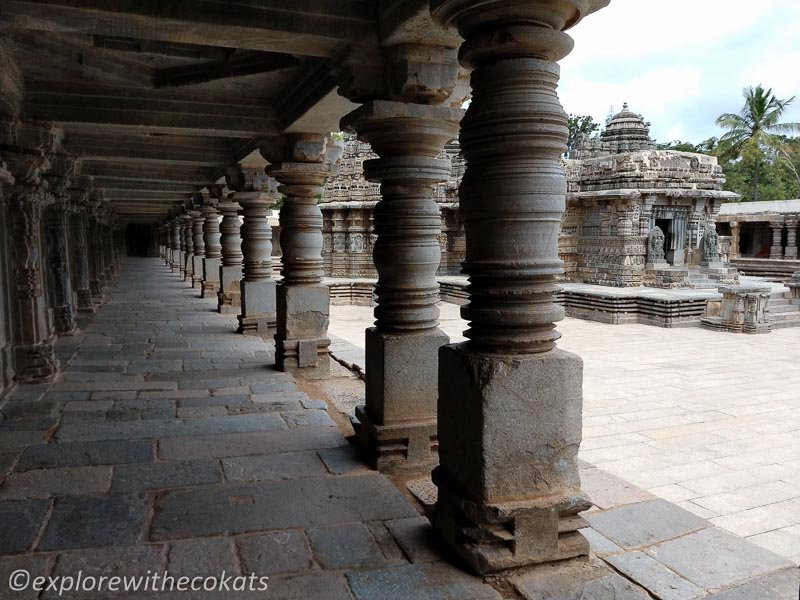
Table of Contents
About Somanathapura, Chennakesava Temple, Mysore
The Chennakesava Temple of Somanathapura was built by the rulers of the Hoysala Dynasty of Karnataka. Just like the Chalukyas who built the rock-cut Badami cave temples, the Hoysalas illustrate the creative skills of the sculptors of that era. The temple has Hindu scriptures moulded in lifelike sculptures from the top to the bottom as well as inside and outside the temple walls.
The temple is nothing less than an art gallery where over 500 sculptors took part. This ornately chiselled ancient temple of India is nothing less than an architectural masterpiece.
While most people believe that the Somanathapura temple is a Shiva temple, contrary to the assumption, the temple is dedicated to three different forms of Krishna, an incarnation of Vishnu. The preceding deities of the temple are Keshava, Venugopala and Janadarna.
While Chennakeshava Temple Belur is bigger and more intricate in its design than Chennakesava Temple Somanathapura, both are the finest examples of Hoysala Architecture. There are over 10 temples in Karnataka itself, with Hoysala architecture.
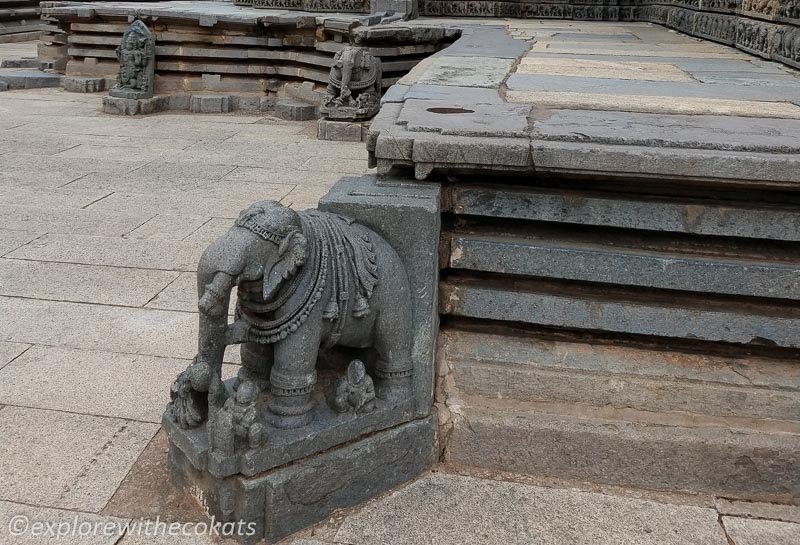
Somanathapura Temple History
The temple is named after its builder. Built in the 13th century by the General of the Hoysala kingdom, the Somnathpur Keshava Temple was constructed by Somanatha Dandnayaka. The information about the sculptors, funds and the kings is found on an inscription placed under the entrance tower of the temple called Gopuram.
Somanatha created an Agrahara (granting of lands to the Brahmins) and allotted the fund for the construction of the temple. Apart from this Keshava temple, he also built other temples in this region such as Panchlinga temple, Lakshminarsimha and Yoganarayana Temple. Unfortunately, all of these are in ruins right now.
Somnathpur temple was destroyed during the Mughal attacks. The first attack was by Malik Kafur, Alauddin Khilji’s general in 1311 and in 1326 Muhammad Bin Tughlaq destroyed the remaining structures. Some parts of the temples were restored by Vijayanagara Kings, later by Wodeyars of Mysuru, and after that by the Archeological Survey of India (ASI).
Due to these attacks, the Somanathapura temple is a non-functional temple.
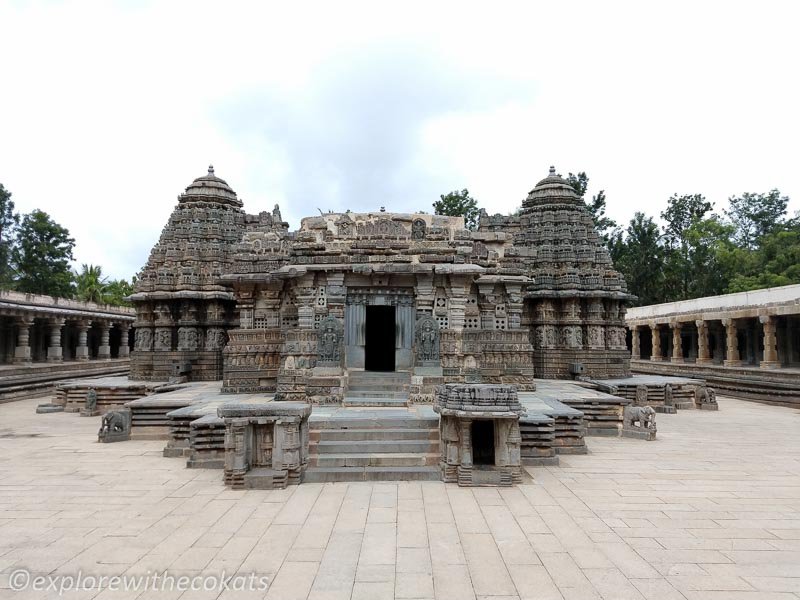
Chennakesava Temple Somanathapura Architecture
From the entrance, a small garden around the walking path overlooking the temple’s Shikhara makes the path interesting.
After the Gopuram visitors have to climb a couple of steps leading to the main shrine. The entire temple is elevated on a star-shaped structure called the mandapa on which the entire temple is built. Be prepared to get bowled with the intricate Hoysala architecture. If you love architecture and history, Do read about the cradle of Indian temple architecture at Aihole – The ancient temple town.
Once those steps are climbed, visitors should start walking toward the left just like a Pradakshina or Parikrama. The stories on the wall are sequenced in a clockwise manner. You can either start with the Parikrama or with the main shrine. There are no rules here as no Puja takes place. I started with the Parikrama as the sculptures were too alluring for me.
Mahadwara (Entrance of the temple)
The Mahadwara is a typical Hoysala style. Built on a level the same as the main shrine, the Mahadwara is a square mandapa. This temple is built in Vesara style (a mix of Nagara – North Indian style and Dravidian South Indian style.
Dwarpalakas
The temple has two Dwarpalaks Jaya and Vijaya. Both resemble the main deity Keshava. They also have four hands holding different symbolic weapons of Lord Vishnu. However, most of their hands and other parts are now broken, and the existing structure tells of its ancient glory.
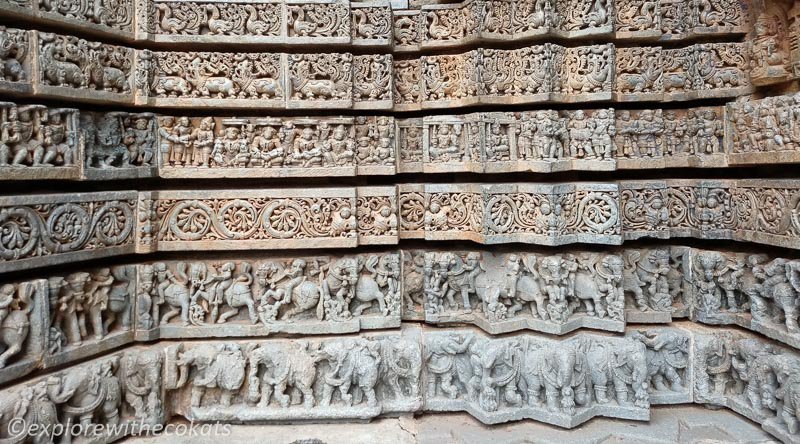
Sculptures on Chennakesava Temple Somanathapura
The exterior wall of the temple has sculptures all over it. In order to give it a good symmetry, the sculptures are divided into horizontal strips with each of them depicting an element of religion, culture or nature.
The Elephant strip
Probably the most common animal adorning temple walls in India is the elephant. The elephant strip is at the base which symbolizes the strength of the Hoysala Kingdom. It is interesting to notice that none of these elephants looks the same. Talk about animation in stone!
The Horse strip
Above the elephants have been staged the horses, another important animal for a strong army. The horse riders seem to be carrying different objects suggesting casual riding by the soldiers, travellers and common men. On the right wall, horses are replaced by camels in some blocks.
Natural Elements strip
Nature plays an important part in all Hindu temples and the sculptors have certainly taken inspiration from the rich flora and fauna of the region. The elements include an imaginary bird surrounded by creepers and flowers.
The Mythological Stories strip
The stories from Hindu Mythology such as Ramayana, Bhagavad Purana, Vishnu Purana, and Mahabharat are carved into the fourth strip of the exterior wall of Chennakesava Temple Karnataka. Some of the important stories carved are of Dasharatha performing Yagya for the heirs from Ramayana, indoor sports of Kushti being practised by the students, stories of Lord Krishna stealing the butter, cloths of the gopis and the killing of Putna has also been engraved in detail.
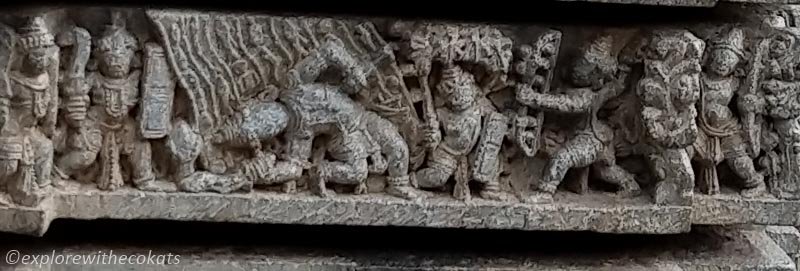
The Makara strip
Makara is a mythological creature having body parts of different animals. This creature has the mouth of a crocodile, the body of a pig, feathers of a peacock, monkey’s eyes, a cow’s ears, the paws of a tiger, and an elephant’s trunk.
The Peacock strip
The topmost band consists of the figures of peacocks or Mayura. It was supposedly a favourite bird of Krishna.
Other noteworthy sculptures at Somanathapura temple
Kamasutra sculptures
There are a few sculptures of amorous couples on the expeditor wall of sabha mandapa.
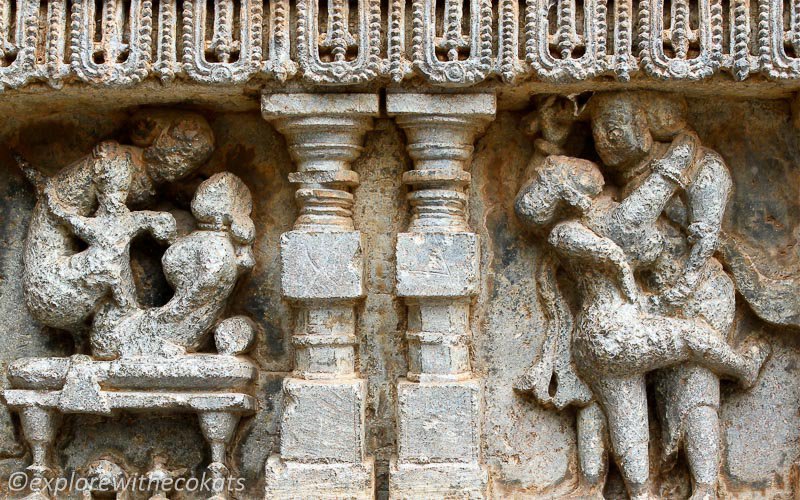
Dancing deities
These are probably the most intricate sculptures of all. These elaborately carved sculptures are majorly the incarnations of Vishnu. Each sculpture is holding something in the hand and has a
The labyrinthine canopy covers their heads. There are approximately 190 such deities on the outer wall.
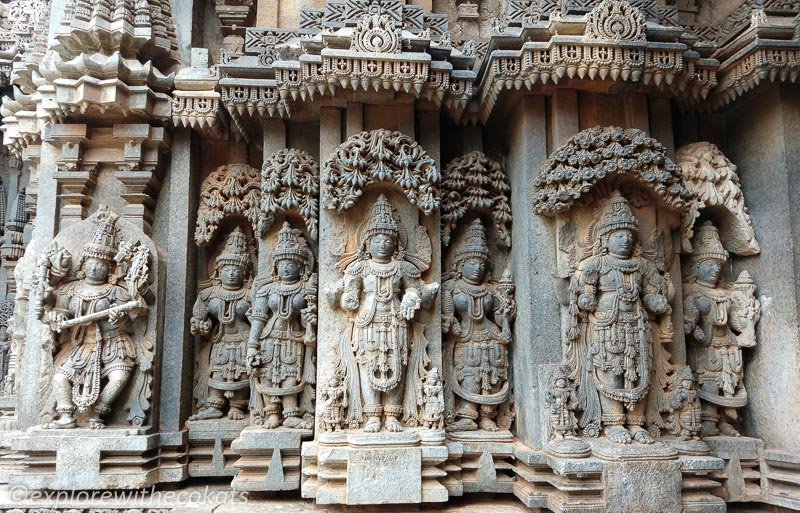
Somanathapura Temple Interior
Navaranga
Inside the Navaranga are nine squares as suggested by ancient Hindu texts on temple design. There are perforated screens on the wall so that light can enter during the day.
The CeilingThe ceiling consists of 16 squares, nine in the sabha mandapa and the remaining seven in the extension near the eastern entrance. These are all carved, each different, each with nature motifs and Hindu theology symbolism embedded. Among them is a palm leaves theme, different stages of lotus opening, endless knots symbolizing karma and samsara, one with ‘dancers, musicians, and soldiers withstanding Vishnu and Shiva in various forms.
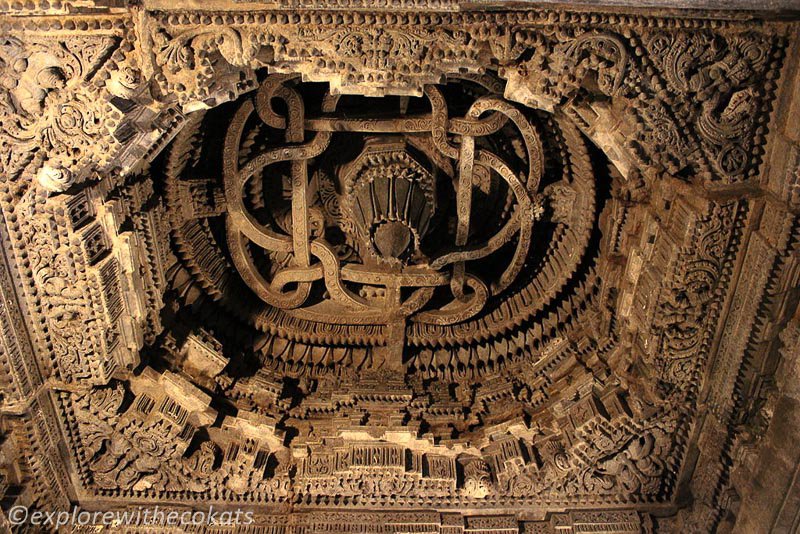
The GarbhagrihaThe Garbhagriha or the Sanctum Sanctorum has an idol of Chennakeshava. It is not the original idol which is why this is a non-functional temple complex.
The Pillars
The pillars are the iconic hallmark of Hoysala architecture. Out of the total 16 pillars in the hall, 2 are handcrafted with geometric and nature designs on them. The others are chiselled with the help of animals attached to a simple machine. These pillars are a combination of 5 different parts attached together. The bottom square, the chiselled body, lamp holding plate and finally the connector to the ceiling are the main parts of the pillar.
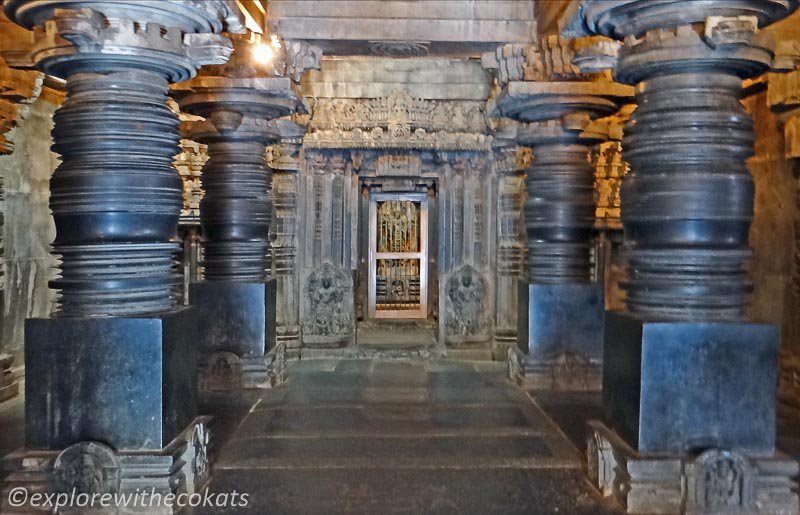
Best time to visit Chennakesava Temple Somanathapura
Timings wise it is ideal to visit it in the early morning to avoid crowds and heat.
The best time to visit the Keshava temple, Somanathapura is in the winters (November – March). Summers could be difficult for visitors due to heat. Monsoon would still have humidity and make the visit uncomfortable.
Entry Fee to Somanathapura Keshava Temple
Rs. 25 for Indian adults and Rs. 300 for foreign adults.
Somanathapura Temple Timings
The Somanathapura temple timing is 8:30 am to 5:30 pm and it is open on all days of the week.
How to Reach Somanathapura Keshava Temple from Bengaluru and Mysore
By road
The Somnathpur Temple is 50 km away from Mysore and thus a short ride away. There are a number of private buses that ply between Mysore and Somanathapura. And it is also possible to hire a private taxi or ride a bike.
There are no direct buses from Bangalore to Somanathapura. One either has to come to Mysore or take a car from Bangalore to reach. Somanathapura is 180km from Bengaluru.
By Air
The Kempegowda International Airport in Bangalore is the nearest airport to Somanathapura for international travellers while Mysore Airport is the nearest for domestic travellers.
By Train
The nearest railway station to the Keshava Temple, Mysore is the Mysore railhead. You can get frequent trains from Chennai, Mumbai and Delhi to Mysore. From Mysore railway station tourists can avail themselves of taxis to the Somanathapura Keshava Temple.
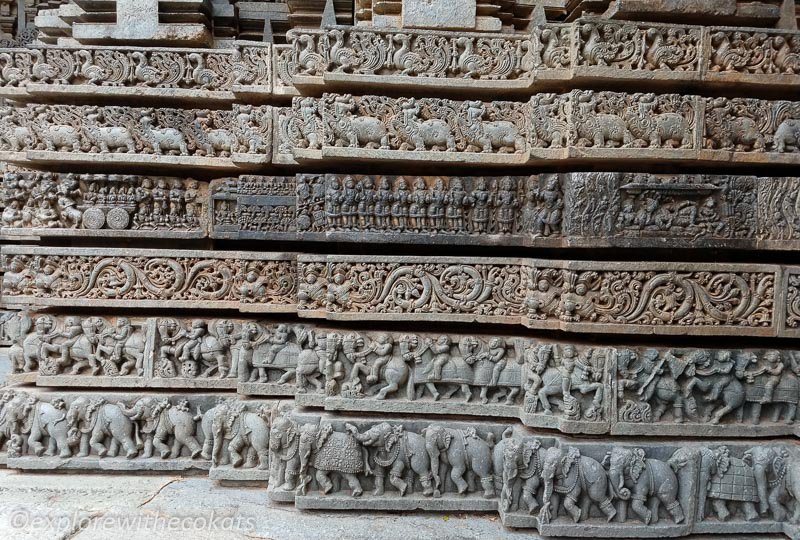
Hotels in Somanathapura: Where to stay
Accommodation facilities are not available at Somanathapura. It is best to spend the night at Mysore. Some options in Mysore are:
Radisson Blu Plaza Hotel Mysore
Where to eat
There are many family-run roadside eateries that serve authentic Dakshin Karnataka cuisine. Just stop by any of them and relish the delicious and fresh vegetarian breakfast or meals.
Places to visit Nearby Somanathapura, Keshava Temple
- Nanjanagud Temples: Lying on the banks of River Kapila, this temple is dedicated to Lord Shiva. This temple is historically important as it is believed that the Shivling of the temple was placed by the famous Rishi Gauthama and was also worshipped by Parashurama when he was on his journey to cleanse his sin of killing his mother.
- Talakadu Beach – Located 25 km from Somanathapura, this place lies on the banks of River Cauvery. Lord Shiva in the form of Vaidyanatheswara is worshipped here. The place is also famous for its sand dunes. It is believed that several temples are still buried under the sand dunes. Coracle Ride at Talakadu Beach is extremely popular.
- Ranganatha Temple, Srirangapatna: Located in the Mysore district, this temple was built by the Ganga dynasty of the Vaishnavite cult. The temple showcases a blended architectural style of Hoysala and Vijaynagara temple designs and is a must-visit.
Sustainable travel tips for Chennakesava Temple Somanathapura
- Being an ancient temple, respect the structures by not sitting on them or drawing on them.
- Like every Hindu temple, devotees are not allowed to wear footwear. Please remove footwear outside the temple.
- Do not enter places which are closed off, and always follow the directions given by the temple security.
- Throw your garbage in the dustbins located at the entrance of the temple.
Read More Temple posts with Intricate Sculptures:
- Mahakuta Temples of Karnataka
- Modhera Sun Temple, Gujarat
- Konark Sun Temple, Odisha
- Trimbakeshwar Temple, Nashik
Read More Karnataka posts:
- All about Belgaum
- Exploring heritage sites of Badami, Aihole, Pattadakal
- Rock-cut Badami Cave Temples
- Things to do in Nirvana Beach, Kumta
Disclaimer: This article includes affiliate links. It means it adds no extra cost to you if you book through the link but I get a referral bonus which helps me earn a little to keep this website up and running.
Pin this post!
